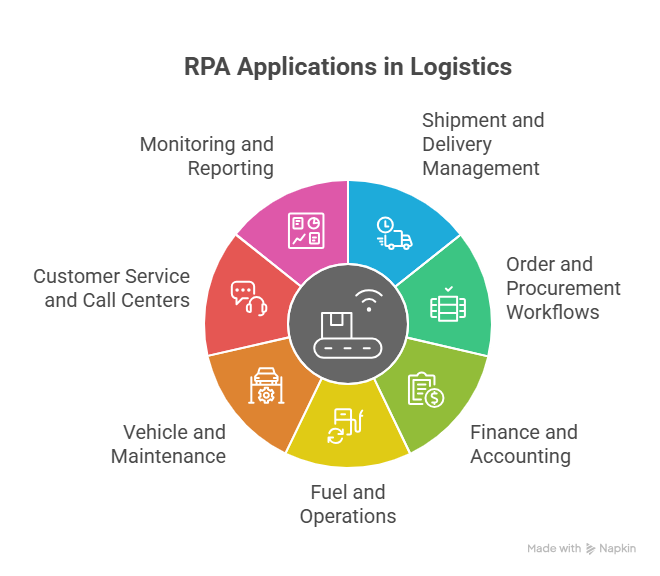Well, I am going to talk about RPA use cases in logistics. But before I dive into the use cases and the rest of the details, here’s something I want to throw light on. Many of you might still be doubtful whether RPA really works, because at least once you’ve heard someone say, “Well, it didn’t work as expected.”
The truth is, most of the time the problem is not RPA itself...it’s that people are not clear about what they actually expect, or they end up choosing the wrong processes to automate.
In fact, research shows that 30 to 50 percent of RPA projects fail to deliver ROI. The main reasons are poor process selection, unclear goals, and weak collaboration between business and IT.
Some companies rushed into automating sales orders or shipment tracking without properly mapping workflows. The bots broke often, maintenance costs piled up, and projects were eventually abandoned.
That’s why I thought of bringing the use cases first. This way, you’ll be sure about the areas where RPA really delivers value. These are processes where you actually have the autonomy to automate, where the workflows are stable, repetitive, and high-volume enough to see real results. Once you know this, it becomes much easier to avoid the pitfalls and focus on what works.
Top RPA Use Cases in Logistics
We have highlighted the top RPA use cases in logistics that directly impact efficiency, accuracy, and cost savings. Each of these areas represents practical opportunities where automation reduces manual effort

1. Shipment and Delivery Management
In logistics, the bulk of effort often happens after goods leave the warehouse. Tracking, validating, updating, and closing records are repetitive yet critical. RPA takes over these tasks, ensuring accuracy, speed, and smooth data flow across systems without constant manual work.
Shipment Tracking: RPA bots connect directly with carrier systems to pull live shipment data. They provide real-time updates, flag delays immediately, and send alerts to customers. This delivers faster visibility, fewer status inquiries, and stronger control over delivery progress.
Less Than Load (LTL) Shipment Management: Smaller shipments usually involve heavy paperwork and higher error risks. With RPA, documents such as PRO numbers and invoices are scanned, validated, and closed automatically. This accelerates processing, reduces mistakes, and keeps LTL shipments moving efficiently.
Logistics ERP Delivery Tracking: Delivery details often sit in multiple systems like ERP and TMS, making it difficult to maintain consistency. RPA updates delivery data across platforms automatically, generates proof of delivery, and synchronizes shipment records for customers and internal teams. Everyone sees the same accurate delivery status in real time.
Facing rising costs from scheduling, tracking, and invoicing inefficiencies, a Dallas-based trucking company turned to RPA. Discover how automation streamlined their operations and reduced errors. Read the full case study.
2. Order and Procurement Workflows
Managing orders and procurement in logistics involves a high volume of repetitive, rule-based tasks. RPA helps streamline these workflows, making them faster, more accurate, and easier to scale as business grows.
Order to Cash (O2C) Automation: RPA takes care of the entire order lifecycle, from entering and validating customer orders to checking inventory, generating invoices, sending reminders, and reconciling payments. This shortens fulfillment cycles, improves cash flow, reduces billing errors, and gives finance teams better real-time visibility into order status and revenue.
Procure to Pay (P2P) Automation: Procurement teams benefit from RPA by automating purchase order creation, invoice matching, compliance checks, and vendor payments. The bots flag discrepancies for quick resolution and ensure controls are audit-ready. This cuts manual effort significantly, speeds up procurement cycles, improves vendor relationships, and strengthens cash flow management.
3. Finance and Accounting
RPA brings speed, accuracy, and consistency to finance functions in logistics by taking over repetitive, error-prone tasks. From asset capitalization to payments, automation not only saves time but also strengthens compliance and financial visibility.
Assets Capitalization: Automate the entire asset lifecycle including creation, posting to systems like SAP or DMS, approvals, depreciation runs, and reporting. This reduces manual entry errors, ensures accurate accounting, and keeps compliance intact.
PO Linking to Invoice: Bots automatically match purchase orders with vendor invoices, flag mismatches, and reconcile records in accounting systems. This accelerates invoice reconciliation, minimizes disputes, and ensures vendors are paid correctly and on time.
Transaction Posting: Automate validation of journal vouchers, route them for approval, and post entries directly into the general ledger. This speeds up period closes, reduces errors, and boosts audit readiness.
Invoice Processing Automation: Use OCR and AI to capture vendor invoice data, process approvals, and enter records into ERP systems. This reduces processing cycle times by up to half, improves accuracy, and keeps cash flow steady with faster payments.
Billing and Payments: Automate recurring billing, detect duplicate invoices or payments, and streamline billing for vehicle repairs and logistics services. This ensures billing consistency, prevents revenue leakage, and improves transparency for both customers and vendors.
4. Fuel and Operations
Managing fuel efficiently is critical in logistics, and RPA helps by automating the capture, validation, and reporting of fuel-related data. This reduces manual errors, saves time, and provides insights that directly impact cost control.
Supplier Fuel Bills Upload: Bots automatically pull fuel bill data from incoming emails and attachments, validate the information, format it, and upload it into ERP or accounting systems. This eliminates repetitive data entry, ensures accuracy, and speeds up financial reconciliation.
Fuel Statement OCR: Using OCR with fuzzy logic, RPA can extract fuel data from PDFs in multiple formats without fixed templates. The data is then converted into structured Excel sheets or ERP-ready files, giving finance and operations teams accurate records without manual effort.
Fuel Consumption Tracking: Automation generates daily, weekly, and monthly reports on fuel usage, reconciles purchases with consumption, and highlights anomalies. This improves transparency, supports fleet optimization, and helps reduce fuel theft, leaks, or inefficiencies.
5. Vehicle and Maintenance
RPA streamlines vehicle and maintenance management by automating repetitive, data-heavy tasks that often slow down logistics teams. From health reporting to accident billing and compliance paperwork, automation ensures accuracy, faster processing, and stronger regulatory adherence.
Vehicle Administration: Bots automatically collect, reconcile, and distribute vehicle health and maintenance reports from emails or shared folders. This ensures timely visibility for fleet managers, helps identify issues early, improves fleet uptime, and creates digital records that support audits and compliance.
Accident Repair Bills: Automation validates accident repair expenses by checking bills against repair history and approvals. Bots then generate compliant, tax-adjusted invoices, reducing the risk of errors or fraud, speeding up claims and payments, and freeing finance teams to focus on exceptions and customer support.
License Forms and Compliance Documents: With OCR and automated workflows, RPA processes license renewals, registrations, and compliance documents. It extracts and inputs data, routes forms for approval, and updates databases automatically, minimizing compliance risks, reducing admin workload, and ensuring timely renewals.
6. Customer Service and Call Centers
RPA is reshaping customer service in logistics by taking over repetitive tasks and allowing teams to deliver faster, more reliable support.
Call Center Support: Bots quickly navigate across CRMs, order management tools, shipment tracking systems and ticketing platforms to bring freight details, delivery status and customer information to agents in real time. They can also create tickets automatically for faster case resolution. This shortens call handling time, reduces errors and frees agents to focus on more complex customer needs.
Customer Service Automation: Common customer inquiries such as delivery updates, invoice checks, refunds or service issues can be handled by RPA workflows, chatbots or automated email responses. Bots validate requests, fetch accurate data and escalate exceptions to human agents when necessary. This enables consistent responses around the clock, lowers call and email volumes, improves accuracy and builds stronger customer trust through faster communication.
7. Monitoring and Reporting
RPA gives logistics teams the ability to monitor operations in real time, handle exceptions as they arise, and keep critical systems in sync without manual effort.
Process Tracking and Operations Monitoring: Bots track every step of the logistics workflow, from order placement to delivery. They pull data from TMS, WMS, ERP, and CRM systems to create a single view of operations. This visibility enables proactive decision-making, eliminates delays caused by manual tracking, and builds transparency for customers and internal teams.
Exception Handling: When something goes wrong—like a shipment delay, missing document, stockout, or invoice mismatch—bots detect the deviation instantly. They can send alerts to the right teams and even trigger corrective actions such as rescheduling shipments or initiating replenishment, reducing disruptions and improving customer satisfaction.
ERP Integration for Inventory and Supply Chain: RPA synchronizes data across ERP, CRM, WMS, and TMS applications, ensuring inventory levels, orders, invoices, and supplier data stay consistent. It also generates real-time reports and dashboards so managers have the insights needed to optimize supply chain performance and make faster, data-driven decisions.
How Leading Companies Use RPA in Logistics, and What They Are Achieving
Across the logistics and supply chain sector, global leaders are proving that RPA is more than a back-office tool. It is becoming a driver of measurable efficiency, accuracy, and growth. Here are some standout examples:
Toyota Motors: Automated routine tasks in transport and warehouse operations, cutting down on manual intervention. This led to smoother coordination between teams, faster reporting, and a noticeable boost in operational efficiency.
Expo Group: Deployed RPA bots to handle booking, receiving, and shipping in freight forwarding. The results were dramatic: average handling time dropped by 87%, error rates fell by almost 100%, and employees were freed to focus on customer-facing tasks.
Genpact: Used RPA for real-time truck monitoring and tracking. By embedding automation in logistics operations, they achieved higher transaction speed, zero errors, and lower operational costs.
All Chemical Transport Corp.: Automated sales order creation, invoice handling, and data validation. This improved data accuracy, cut turnaround time, and supported a 35% annual growth rate without increasing admin costs.
Global Freight & Supply Chain Provider: Applied RPA in back-office operations, including customer service. Automation reduced employee workload, improved response speed, and strengthened accuracy in logistics workflows.
A global logistics firm faced delays due to a slow legacy .NET system. Nalashaa modernized it with a new enterprise platform and optimized UI, boosting speed and usability. Read the full case study.
Let’s Quantify the Impact of RPA in Logistics
Companies adopting RPA in logistics report 30–40% average cost reductions in repetitive processes like order processing, freight invoicing, and shipment documentation.
61% of logistics RPA users achieved cost reduction, while 78% plan to increase automation spend in the next three years.
ROI in logistics automation ranges from 30% to 200% in the first year, with mature programs reaching up to 300% long term.
RPA reduces order processing and fulfillment times by up to 50%.
Warehouse efficiency improves by up to 40% when RPA is integrated with other automation technologies.
Nearly 70% of organizations using RPA cite improved data quality and fewer errors as a top benefit.
Productivity improvements of up to 500% have been documented in automated order workflows.
Shipment handling volumes have increased by 200–300% for logistics firms adopting RPA.
As of 2025, 24% of organizations have implemented RPA in logistics.
66% of logistics companies expect to adopt RPA in the near term.
Before We Wind Up
Well, one thing is very clear, opportunities are endless, but what matters is how prepared you’re for it. Having a clear idea of how you plan to bring RPA use cases into your logistics operations is crucial. The first step is mapping the workflows you want to automate and making sure they can scale across other processes as your needs grow.
At this stage, what you need most is the guidance of an experienced RPA consultant who can help you align strategy with execution. If you have an automation requirement in mind, let us know. We can help you understand the opportunity in it. We’re just a form fill away.


